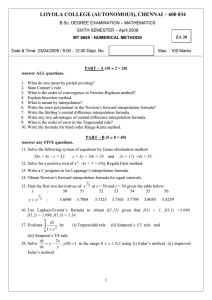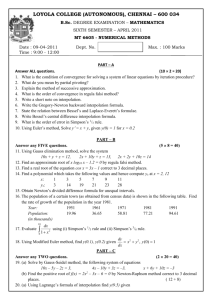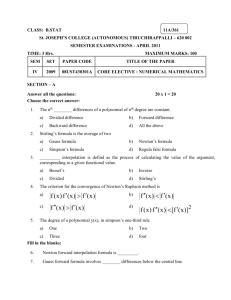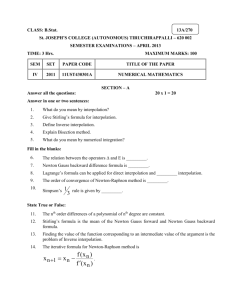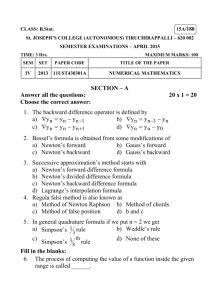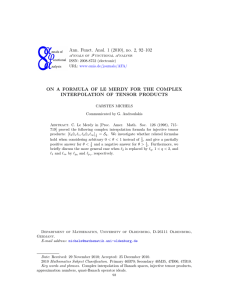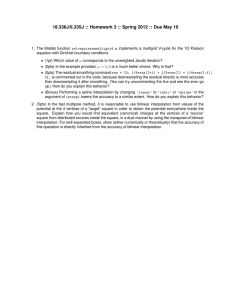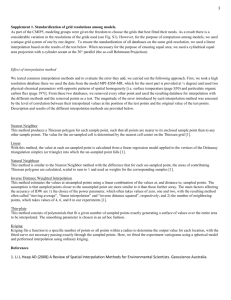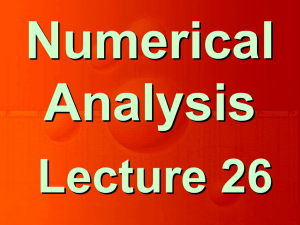MT 6605 - Loyola College
advertisement
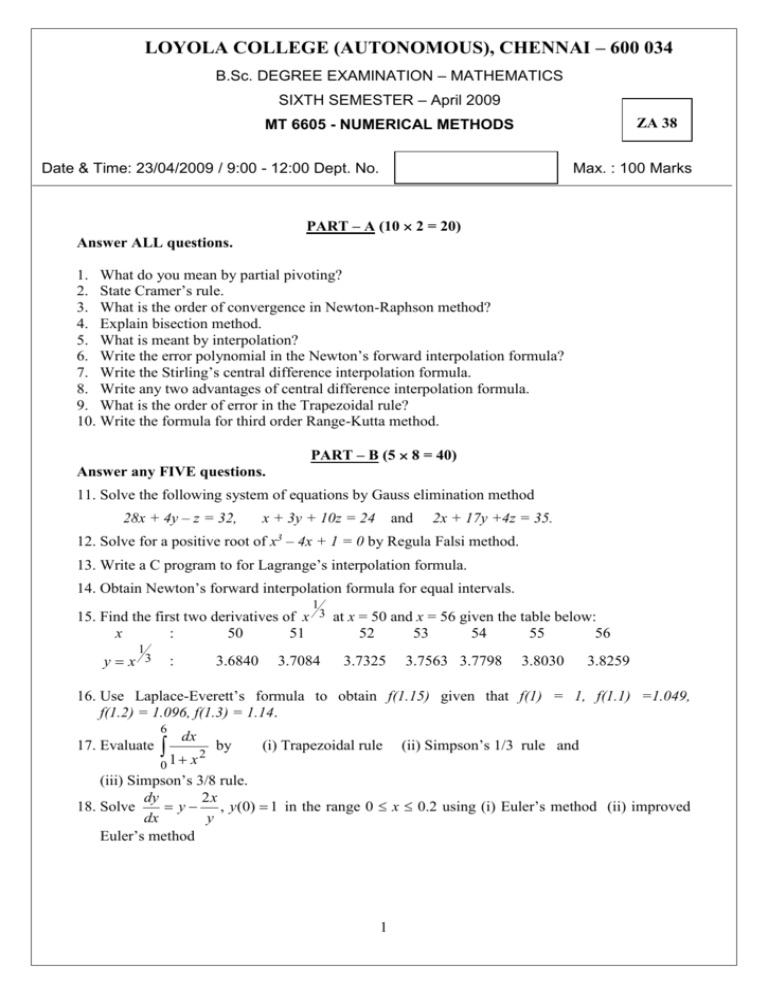
LOYOLA COLLEGE (AUTONOMOUS), CHENNAI – 600 034 B.Sc. DEGREE EXAMINATION – MATHEMATICS SIXTH SEMESTER – April 2009 ZA 38 MT 6605 - NUMERICAL METHODS Date & Time: 23/04/2009 / 9:00 - 12:00 Dept. No. Max. : 100 Marks PART – A (10 2 = 20) Answer ALL questions. 1. What do you mean by partial pivoting? 2. State Cramer’s rule. 3. What is the order of convergence in Newton-Raphson method? 4. Explain bisection method. 5. What is meant by interpolation? 6. Write the error polynomial in the Newton’s forward interpolation formula? 7. Write the Stirling’s central difference interpolation formula. 8. Write any two advantages of central difference interpolation formula. 9. What is the order of error in the Trapezoidal rule? 10. Write the formula for third order Range-Kutta method. PART – B (5 8 = 40) Answer any FIVE questions. 11. Solve the following system of equations by Gauss elimination method 28x + 4y – z = 32, x + 3y + 10z = 24 and 2x + 17y +4z = 35. 12. Solve for a positive root of x3 – 4x + 1 = 0 by Regula Falsi method. 13. Write a C program to for Lagrange’s interpolation formula. 14. Obtain Newton’s forward interpolation formula for equal intervals. 1 15. Find the first two derivatives of x 3 at x = 50 and x = 56 given the table below: x : 50 51 52 53 54 55 56 1 yx 3 : 3.6840 3.7084 3.7325 3.7563 3.7798 3.8030 3.8259 16. Use Laplace-Everett’s formula to obtain f(1.15) given that f(1) = 1, f(1.1) =1.049, f(1.2) = 1.096, f(1.3) = 1.14. 6 17. Evaluate dx 1 x2 by (i) Trapezoidal rule (ii) Simpson’s 1/3 rule and 0 (iii) Simpson’s 3/8 rule. dy 2x y , y (0) 1 in the range 0 x 0.2 using (i) Euler’s method (ii) improved 18. Solve dx y Euler’s method 1 PART – C (2 20 = 40) Answer any TWO questions. 19. (a) Solve by Gauss-Seidel Method, the following system of equations. 28x + 4y – z = 32, x + 3y + 10z = 24, and 2x + 17y + 4z = 35 (b) Find the real positive root of 3x – cos x – 1 = 0 by Newton-Raphson method correct to 6 decimal places. 20. (a) From the following table find f(x) and hence f(6) using Newton’s divided difference formula. x : 1 2 7 8 f(x) : 1 5 5 4 (b) The following table gives the value of density of saturated water for various temperatures of saturated stream. Tempo C ( = T) : 100 150 200 250 300 3 Density hg/m (= d) : 958 917 865 799 712 Find by interpolation, the densities when the temperatures are 130oC and 275oC respectively. 21. (a) Using Gauss’s forward interpolation formula, find the value of log 337.5 from the following table. x : 310 320 330 340 350 360 yx = log x : 2.4914 2.5052 2.5185 2.5315 2.5441 2.5563 (b) Using Bessel’s formula, find the derivative of f(x) at x = 3.5 from the following table. x : 3.47 3.48 3.49 3.50 3.51 3.52 3.53 f(x) : 0.193 0.195 0.198 0.201 0.203 0.206 0.208 22. (a) Using Range-Kutta method of fourth order, solve for y(0.1) and y(0.2) given that y = xy + y2, y(0) =1. (b) Develop a C program to implement Simpson’s 3/8 rule. ******************** 2
